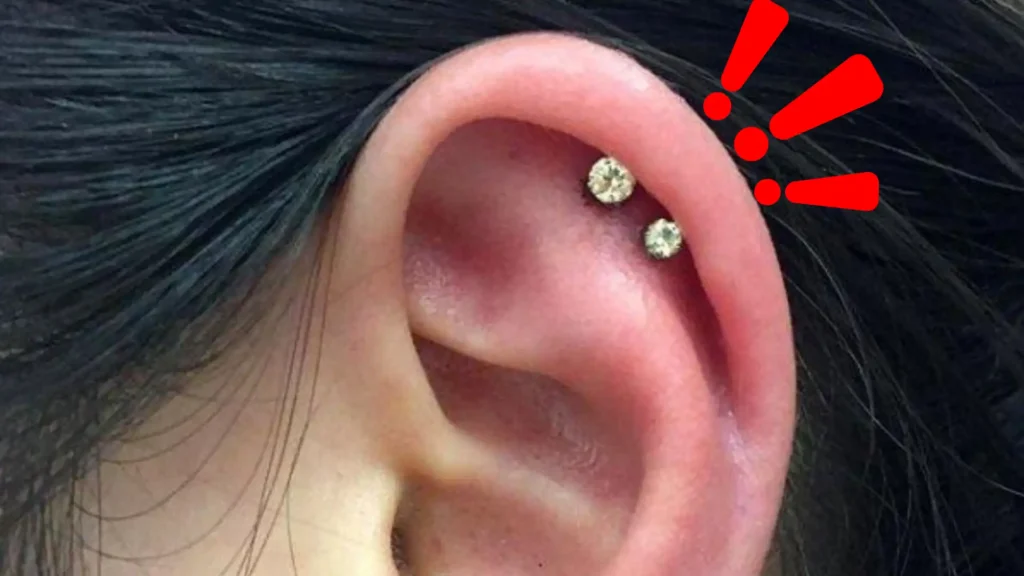Helix piercings are a popular choice for those looking to add some edge to their appearance. However, due to the nature of cartilage, these piercings often come with a unique set of challenges, including the development of bumps. This detailed guide will help you understand why these bumps occur, how to treat them, and the best practices for aftercare to ensure your helix piercing heals beautifully.
What to Expect During the Healing Process
Initial Healing Phase (First Few Days):
During the first few days after getting a helix piercing, it’s normal to notice some initial swelling and redness. The area around the piercing might feel tender, and you could see a bump or general swelling near the jewelry. Other common symptoms include:
- Minor bleeding
- Bruising
- Mild pain
Ongoing Healing Phase (4 to 12 Months):
As the healing progresses, which can take anywhere from four to twelve months, you might experience:
- Discoloration around the piercing site
- Itching
- Oozing of a whitish-yellow fluid
- Formation of crusts on and around your jewelry
Cartilage piercings heal from the outside in, which means they may appear healed on the surface long before the healing process is actually complete.
Types of Bumps That Can Develop
Bumps are relatively common with helix piercings and can appear shortly after the initial piercing or even long after it seems to have healed. Understanding the type of bump you’re dealing with is crucial for effective treatment.
Pustule: This is a blister or pimple filled with pus, typically occurring shortly after the piercing.
Granuloma: A lesion that often develops about six weeks post-piercing.
Keloid: A type of thick scar that can form at the piercing site, usually appearing as a raised, overgrown area of scar tissue.
Causes of Piercing Bumps
Several factors can contribute to the formation of bumps around your helix piercing:
- Allergic Reactions: Many people are allergic to certain metals, particularly nickel. If you’re allergic, you might experience intense itchiness, redness, and tenderness around the piercing.
- Poor Aftercare: Inadequate cleaning or handling of the piercing can lead to irritation and infection.
- Genetics: Some individuals are more prone to developing keloids or other types of scarring.
- Random Chance: Sometimes, despite proper care, bumps can still form due to factors beyond your control.
Effective Treatments for Piercing Bumps
1. Identify and Replace Irritating Jewelry:
If you suspect a metal allergy, switching to hypoallergenic jewelry is essential. Recommended materials include:
- 18- or 24-karat gold
- Stainless steel
- Titanium
- Niobium
2. Maintain a Proper Cleaning Regimen:
Clean your piercing two to three times daily using a fragrance-free antimicrobial soap or a cleanser recommended by your piercer. Steps include:
- Wash your hands thoroughly with soap and warm water before touching your piercing.
- Use a gentle cleanser and rinse thoroughly to remove any soap residue.
- Dry the area gently with a paper towel to avoid contamination from cloth towels.
Avoid using harsh chemicals like benzalkonium chloride, iodopovidone, chlorhexidine, rubbing alcohol, and hydrogen peroxide, as these can irritate the skin and delay healing.
3. Use Saline or Sea Salt Soaks:
Saline or sea salt soaks help to wash away harmful bacteria and debris. To prepare a soak:
- Dissolve ¼ teaspoon of fine sea salt in 8 ounces of warm water.
- Soak the piercing for about five minutes, either by dipping your ear in the solution or using a soaked paper towel.
- Gently pat the area dry with a clean paper towel.
4. Apply Chamomile Compresses:
Chamomile has powerful antioxidants and anti-inflammatory properties. To make a compress:
- Steep a chamomile tea bag in warm water for 4 to 6 minutes.
- Apply the tea bag to the piercing for 5 to 10 minutes.
- Alternate with saline soaks if desired, but avoid chamomile if you have a ragweed allergy.
When to Seek Medical Attention
While minor swelling and redness are typical, more severe symptoms could indicate an infection. Consult your piercer or a healthcare professional if you experience:
- Uncomfortable pain or swelling
- Thick, smelly discharge (yellow, green, or gray)
- Fever
- Chills
- Nausea
- Vomiting
- Dizziness
Key Takeaway
Helix piercings are a stylish and unique form of body art, but they require careful attention and proper aftercare to prevent and manage complications. By understanding the potential issues and following recommended treatments, you can ensure your helix piercing heals well and remains a beautiful addition to your look.
Regular cleaning, using hypoallergenic jewelry, and knowing when to seek professional help are essential steps in maintaining a healthy helix piercing. With diligence and proper care, you can enjoy your piercing without the hassle of bumps and infections.
Discover more trends:
Follow us on: : 📌Pinterest | 📘Facebook





